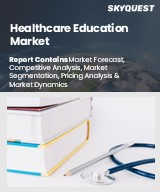
|
시장보고서
상품코드
1512064
헬스케어 교육 시장 규모, 점유율, 동향 분석 보고서 : 공급자별, 용도별, 최종사용자별, 지역별, 부문별 예측(2024-2030년)Healthcare Education Market Size, Share & Trends Analysis Report By Provider, By Application (Academic Education, Cardiology), By Delivery Mode, By End-use (Physicians, Non-physicians), By Region, And Segment Forecasts, 2024 - 2030 |
||||||
헬스케어 교육 시장 성장과 동향
Grand View Research, Inc.의 최신 보고서에 따르면, 세계 헬스케어 교육 시장 규모는 2024년부터 2030년까지 연평균 13.3% 성장하여 2030년에는 2,642억 6,000만 달러에 달할 것으로 예상됩니다.
이 같은 성장의 주요 요인은 의료 종사자의 지속적인 교육이 필요한 의학의 지속적인 발전, 학습 경험을 향상시키는 가상현실 및 시뮬레이션 기반 학습과 같은 기술의 통합, 숙련된 의료 인력을 필요로 하는 전 세계 보건 문제의 증가 등입니다. 또한, 규제 요건, 원격의료 및 유전체학 등의 분야에서 전문 기술에 대한 수요 증가, 예방 의료에 대한 인식 증가, 의료 서비스의 세계화 등이 의료 교육 및 훈련 프로그램에 대한 수요를 증가시키고 있습니다.
헬스케어 교육 부문은 통합의 기회, 디지털화, 학생 성과에 대한 관심, 헬스케어 조직 내 기술 플랫폼의 광범위한 채택 등에 힘입어 큰 성장세를 보이고 있습니다. 교육 기업들은 이러한 새로운 전략에 우선순위를 두고, 경험이 풍부한 플랫폼들은 관련 및 보완 서비스 분야로 진출하고, 혁신적인 접근 방식과 시장 다변화를 통해 진화하는 헬스케어 교육 훈련 수요에 대응하는 것이 시장 성장의 원동력이 되고 있습니다.
인구 증가와 의료 접근성 확대로 인한 의료 전문가에 대한 수요 증가로 이 시장은 크게 성장하고 있습니다. VR, AR, AI, 시뮬레이션 기반 학습과 같은 기술 발전은 교육 경험을 변화시키고 있으며, COVID-19 사태는 온라인 학습과 원격 학습으로의 전환을 가속화하여 교육을 더욱 친숙하고 유연하게 만들었습니다. 지속적인 전문성 개발은 의료 전문가들이 의학의 발전에 발맞추기 위해 필수적이며, 지속적인 교육에 대한 요구가 증가하고 있습니다. 또한, 실제 환자를 위험에 빠뜨리지 않고 종합적인 교육과 실습 경험을 제공할 수 있는 다학제간 교육 및 시뮬레이션 기반 학습이 확산되고 있습니다.
헬스케어 교육 시장 보고서 하이라이트
- 대학 및 학술 센터 분야가 시장을 주도하며 2023년 세계 매출의 32.0%를 차지했습니다. 지속적인 학습의 중요성이 이러한 성장의 원동력이 되고 있으며, 대학 및 학술 센터는 의료 전문가가 이 분야의 최신 발전을 파악할 수 있도록 다양한 평생 교육 과정을 제공하고 있습니다.
- 방사선 분야는 2023년 가장 큰 수익 점유율을 차지했습니다. 이는 엑스레이, CT 스캔, MRI, 초음파 등 의료 영상 기술이 다양한 질환의 진단 및 치료에 대한 수요가 높아지면서 자격을 갖춘 방사선과 전문의에 대한 수요가 높기 때문입니다.
- 교실 기반 코스 부문이 2023년 가장 큰 시장 수익 점유율을 차지한 이유는 실용적인 학습 기술 제공, 시장 개척, 학생과 강사의 협업, 팀워크 육성, 실용적인 기술 향상에 기인한 것으로 분석됐습니다.
- 2023년 시장 수익은 조기 진로 개척에 대한 관심 증가, 고등학교의 헬스케어 직업 옵션 도입 노력, 학부 유학 추진 등으로 인해 학생 대상 분야가 대부분을 차지했습니다.
목차
제1장 조사 방법과 범위
제2장 주요 요약
제3장 시장 변수, 동향, 범위
- 시장 계보
- 업계 밸류체인 분석
- 헬스케어 교육 시장 - 시장 역학
- 시장 성장 촉진요인 분석
- 시장 성장 억제요인 분석
- 업계 과제
- 업계 기회
- 비즈니스 환경 툴 분석 : 헬스케어 교육 시장
- Porter's Five Forces 분석
- PESTLE 분석
제4장 헬스케어 교육 시장 : 시스템 유형별 추정·동향 분석
- 시스템 유형별 헬스케어 교육 시장 : 주요 포인트
- 헬스케어 교육 시장 : 시스템 유형 변동 분석, 2023년 및 2030년
- 지속적 의학 교육 프로바이더
- 교육 플랫폼
- 학습 관리 시스템
- 대학 및 학술 센터
- OEM/제약회사
- 의료 시뮬레이션
제5장 헬스케어 교육 시장 : 용도별 추정·동향 분석
- 헬스케어 교육 시장, 용도별 : 주요 포인트
- 헬스케어 교육 시장 : 용도별 변동 분석, 2023년 및 2030년
- 학술 교육
- 심장병학
- 방사선과
- 신경학
- 소아과
- 내과
- 기타
제6장 헬스케어 교육 시장 : 제공 형태별 추정·동향 분석
- 헬스케어 교육 시장, 제공 형태별 : 주요 포인트
- 헬스케어 교육 시장 : 제공 형태별 변동 분석, 2023년 및 2030년
- 교실 기반 코스
- E-Learning 솔루션
제7장 헬스케어 교육 시장 : 최종 용도별 추정·동향 분석
- 헬스케어 교육 시장, 최종 용도별 : 주요 포인트
- 헬스케어 교육 시장 : 최종 용도 변동 분석, 2023년 및 2030년
- 학생
- 의사
- 비의사
제8장 헬스케어 교육 시장 : 지역별 추정·동향 분석
- 헬스케어 교육 시장 : 지역 변동 분석, 2023년 및 2030년
- 북미
- 시장 추정과 예측, 2017-2030년
- 미국
- 캐나다
- 유럽
- 시장 추정과 예측, 2017-2030년
- 독일
- 영국
- 프랑스
- 아시아태평양
- 시장 추정과 예측, 2017-2030년
- 중국
- 일본
- 인도
- 호주
- 한국
- 라틴아메리카
- 시장 추정과 예측, 2017-2030년
- 브라질
- 멕시코
- 중동 및 아프리카
- 시장 추정과 예측, 2017-2030년
- 사우디아라비아
- 아랍에미리트
- 남아프리카공화국
제9장 경쟁 상황
- 기업 분류
- 기업의 시장 포지셔닝
- 기업 히트맵 분석
- 전략 매핑
- 기업 개요/상장 기업
- ARTICULATE GLOBAL INC
- COURSERA INC
- ELSEVIER
- GE HEALTHCARE
- HEALTHSTREAM
- INFOR
- KONINKLIJKE PHILIPS NV
- SIEMENS HEALTHCARE PRIVATE LIMITED
- STRYKER
- SYMPLR
Healthcare Education Market Growth & Trends:
The global healthcare education market size is expected to reach USD 264.26 billion by 2030, growing at a CAGR of 13.3% from 2024 to 2030, according to a new report by Grand View Research, Inc. This growth is primarily driven by the continuous advancements in medical science necessitating ongoing education for healthcare professionals, the integration of technology such as virtual reality and simulation-based learning enhancing learning experiences, and increasing global health challenges demanding a skilled healthcare workforce. Additionally, regulatory requirements, rising demand for specialized skills in areas such as telemedicine and genomics, growing awareness about preventive healthcare, and the globalization of healthcare services are all contributing to the demand for healthcare education and training programs.
The healthcare education sector is experiencing significant growth propelled by opportunities for integration, waves of digitization, emphasis on student outcomes, and the widespread adoption of technology platforms within healthcare organizations. Education companies are prioritizing these new strategies, while experienced platforms seek to expand into related and complementary service areas and shift towards innovative approaches and diversification to meet the evolving needs of healthcare education and training is driving the market growth.
The market is experiencing substantial growth due to an increased demand for healthcare professionals driven by growing populations and expanded healthcare access. Technological advancements, such as VR, AR, AI, and simulation-based learning, are transforming the educational experience. The COVID-19 pandemic accelerated the shift to online and remote learning, making education more accessible and flexible. Continuous professional development is essential for healthcare professionals to stay updated with medical advancements, increasing the demand for ongoing training. Additionally, interdisciplinary education and simulation-based learning are becoming more popular, providing comprehensive training and practical experience without risk to real patients.
Healthcare Education Market Report Highlights:
- The universities and academic centers segment led the market, representing 32.0% of global revenue in 2023. The importance of continuous learning drives this growth, as universities and academic centers offer extensive continuing education courses to keep healthcare professionals updated with the latest advancements in the field.
- The radiology segment held the largest revenue share in in 2023. This is due to the high demand for medical imaging technologies such as X-rays, CT scans, MRIs, and ultrasounds for diagnosing and treating a wide range of medical conditions, which creates a high demand for qualified radiologists.
- The classroom-based courses segment held the largest market revenue share in 2023 due to its provision of hands-on learning skills, development, and collaboration among students and instructors, fostering teamwork and practical skill enhancement.
- The student segment dominated the market revenue in 2023, driven by a growing focus on early career development, efforts to introduce healthcare career options in high schools, and promotion of undergraduate studies.
Table of Contents
Chapter 1. Methodology and Scope
- 1.1. Research Methodology
- 1.2. Research Scope and Assumptions
- 1.3. Information Procurement
- 1.3.1. Purchased Database
- 1.3.2. Gvr's Internal Database
- 1.3.3. Secondary Sources & Third-Party Perspectives
- 1.3.4. Primary Research
- 1.4. Information Analysis
- 1.4.1. Data Analysis Models
- 1.5. Market Formulation & Data Visualization
- 1.6. Data Validation & Publishing
Chapter 2. Executive Summary
- 2.1. Market Outlook
- 2.2. Segmental Outlook
- 2.3. Competitive Insights
Chapter 3. Market Variables, Trends, and Scope
- 3.1. Market Lineage
- 3.2. Industry Value Chain Analysis
- 3.3. Healthcare Education Market - Market Dynamics
- 3.3.1. Market Driver Analysis
- 3.3.1.1. Increasing adoption of digital learning
- 3.3.1.2. Growing demand for training due to the continuous advancements in medical technology.
- 3.3.2. Market Restraint Analysis
- 3.3.2.1. Lack of skilled trainers and instructors with adequate technical knowledge
- 3.3.3. Industry Challenges
- 3.3.4. Industry Opportunities
- 3.3.1. Market Driver Analysis
- 3.4. Business Environmental Tools Analysis: Healthcare Education Market
- 3.4.1. porter's Five Forces Analysis
- 3.4.1.1. Bargaining Power of Suppliers
- 3.4.1.2. Bargaining Power of Buyers
- 3.4.1.3. Threat of Substitution
- 3.4.1.4. Threat of New Entrants
- 3.4.1.5. Competitive Rivalry
- 3.4.2. Pestle Analysis
- 3.4.2.1. Political Landscape
- 3.4.2.2. Economic Landscape
- 3.4.2.3. Social Landscape
- 3.4.2.4. Technology Landscape
- 3.4.2.5. Environmental Landscape
- 3.4.2.6. Legal Landscape
- 3.4.1. porter's Five Forces Analysis
Chapter 4. Healthcare Education Market: System Type Estimates & Trend Analysis
- 4.1. Healthcare Education Market, by System Type: Key Takeaways
- 4.2. Healthcare Education Market: System Type Movement Analysis, 2023 & 2030
- 4.3. Continuing Medical Education Providers
- 4.3.1. Market Estimates And Forecasts, 2017 - 2030 (USD Million)
- 4.4. Educational Platforms
- 4.4.1. Market Estimates And Forecasts, 2017 - 2030 (USD Million)
- 4.5. Learning Management Systems
- 4.5.1. Market Estimates And Forecasts, 2017 - 2030 (USD Million)
- 4.6. Universities And Academic Centers
- 4.6.1. Market Estimates And Forecasts, 2017 - 2030 (USD Million)
- 4.7. Oems/Pharmaceutical Companies
- 4.7.1. Market Estimates And Forecasts, 2017 - 2030 (USD Million)
- 4.8. Medical Simulation
- 4.8.1. Market Estimates And Forecasts, 2017 - 2030 (USD Million)
Chapter 5. Healthcare Education Market: Application Estimates & Trend Analysis
- 5.1. Healthcare Education Market, by Application: Key Takeaways
- 5.2. Healthcare Education Market: Application Movement Analysis, 2023 & 2030
- 5.3. Academic Education
- 5.3.1. Market Estimates And Forecasts, 2017 - 2030 (USD Million)
- 5.4. Cardiology
- 5.4.1. Market Estimates And Forecasts, 2017 - 2030 (USD Million)
- 5.5. Radiology
- 5.5.1. Market Estimates And Forecasts, 2017 - 2030 (USD Million)
- 5.6. Neurology
- 5.6.1. Market Estimates And Forecasts, 2017 - 2030 (USD Million)
- 5.7. Pediatrics
- 5.7.1. Market Estimates And Forecasts, 2017 - 2030 (USD Million)
- 5.8. Internal Medicine
- 5.8.1. Market Estimates And Forecasts, 2017 - 2030 (USD Million)
- 5.9. Others
- 5.9.1. Market Estimates And Forecasts, 2017 - 2030 (USD Million)
Chapter 6. Healthcare Education Market: Delivery Mode Estimates & Trend Analysis
- 6.1. Healthcare Education Market, by Delivery Mode: Key Takeaways
- 6.2. Healthcare Education Market: Delivery Mode Movement Analysis, 2023 & 2030
- 6.3. Classroom-based Courses
- 6.3.1. Market Estimates And Forecasts, 2017 - 2030 (USD Million)
- 6.4. E-Learning Solutions
- 6.4.1. Market Estimates And Forecasts, 2017 - 2030 (USD Million)
Chapter 7. Healthcare Education Market: End Use Estimates & Trend Analysis
- 7.1. Healthcare Education Market, by End Use: Key Takeaways
- 7.2. Healthcare Education Market: End Use Movement Analysis, 2023 & 2030
- 7.3. Students
- 7.3.1. Market Estimates And Forecasts, 2017 - 2030 (USD Million)
- 7.4. Physicians
- 7.4.1. Market Estimates And Forecasts, 2017 - 2030 (USD Million)
- 7.5. Non-Physicians
- 7.5.1. Market Estimates And Forecasts, 2017 - 2030 (USD Million)
Chapter 8. Healthcare Education Market: Regional Estimates & Trend Analysis
- 8.1. Healthcare EducationMarket: Regional Movement Analysis, 2023 & 2030
- 8.2. North America
- 8.2.1. Market Estimates And Forecasts, 2017 - 2030 (USD Million)
- 8.2.2. U.S.
- 8.2.2.1. Market estimates and forecasts, 2017 - 2030 (USD Million)
- 8.2.3. Canada
- 8.2.3.1. Market estimates and forecasts, 2017 - 2030 (USD Million)
- 8.3. Europe
- 8.3.1. Market Estimates And Forecasts, 2017 - 2030 (USD Million)
- 8.3.2. Germany
- 8.3.2.1. Market estimates and forecasts, 2017 - 2030 (USD Million)
- 8.3.3. U.K.
- 8.3.3.1. Market estimates and forecasts, 2017 - 2030 (USD Million)
- 8.3.4. France
- 8.3.4.1. Market estimates and forecasts, 2017 - 2030 (USD Million)
- 8.4. Asia Pacific
- 8.4.1. Market Estimates And Forecasts, 2017 - 2030 (USD Million)
- 8.4.2. China
- 8.4.2.1. Market estimates and forecasts, 2017 - 2030 (USD Million)
- 8.4.3. Japan
- 8.4.3.1. Market estimates and forecasts, 2017 - 2030 (USD Million)
- 8.4.4. India
- 8.4.4.1. Market estimates and forecasts, 2017 - 2030 (USD Million)
- 8.4.5. Australia
- 8.4.5.1. Market estimates and forecasts, 2017 - 2030 (USD Million)
- 8.4.6. South Korea
- 8.4.6.1. Market estimates and forecasts, 2017 - 2030 (USD Million)
- 8.5. Latin America
- 8.5.1. Market Estimates And Forecasts, 2017 - 2030 (USD Million)
- 8.5.2. Brazil
- 8.5.2.1. Market estimates and forecasts, 2017 - 2030 (USD Million)
- 8.5.3. Mexico
- 8.5.3.1. Market estimates and forecasts, 2017 - 2030 (USD Million)
- 8.6. Middle East & Africa
- 8.6.1. Market Estimates And Forecasts, 2017 - 2030 (USD Million)
- 8.6.2. KSA
- 8.6.2.1. Market estimates and forecasts, 2017 - 2030 (USD Million)
- 8.6.3. UAE
- 8.6.3.1. Market estimates and forecasts, 2017 - 2030 (USD Million)
- 8.6.4. South Africa
- 8.6.4.1. Market estimates and forecasts, 2017 - 2030 (USD Million)
Chapter 9. Competitive Landscape
- 9.1. Company Categorization
- 9.2. Company Market Positioning
- 9.3. Company Heat Map Analysis
- 9.4. Strategy Mapping
- 9.5. Company Profiles/Listing
- 9.5.1. ARTICULATE GLOBAL INC
- 9.5.1.1. Overview
- 9.5.1.2. Financial Performance
- 9.5.1.3. Product Benchmarking
- 9.5.1.4. Strategic Initiatives
- 9.5.2. COURSERA INC
- 9.5.2.1. Overview
- 9.5.2.2. Financial Performance
- 9.5.2.3. Product Benchmarking
- 9.5.2.4. Strategic Initiatives
- 9.5.3. ELSEVIER
- 9.5.3.1. Overview
- 9.5.3.2. Financial Performance
- 9.5.3.3. Product Benchmarking
- 9.5.3.4. Strategic Initiatives
- 9.5.4. GE HEALTHCARE
- 9.5.4.1. Overview
- 9.5.4.2. Financial Performance
- 9.5.4.3. Product Benchmarking
- 9.5.4.4. Strategic Initiatives
- 9.5.5. HEALTHSTREAM
- 9.5.5.1. Overview
- 9.5.5.2. Financial Performance
- 9.5.5.3. Product Benchmarking
- 9.5.5.4. Strategic Initiatives
- 9.5.6. INFOR
- 9.5.6.1. Overview
- 9.5.6.2. Financial Performance
- 9.5.6.3. Product Benchmarking
- 9.5.6.4. Strategic Initiatives
- 9.5.7. KONINKLIJKE PHILIPS N.V.
- 9.5.7.1. Overview
- 9.5.7.2. Financial Performance
- 9.5.7.3. Product Benchmarking
- 9.5.7.4. Strategic Initiatives
- 9.5.8. SIEMENS HEALTHCARE PRIVATE LIMITED
- 9.5.8.1. Overview
- 9.5.8.2. Financial Performance
- 9.5.8.3. Product Benchmarking
- 9.5.8.4. Strategic Initiatives
- 9.5.9. STRYKER
- 9.5.9.1. Overview
- 9.5.9.2. Financial Performance
- 9.5.9.3. Product Benchmarking
- 9.5.9.4. Strategic Initiatives
- 9.5.10. SYMPLR
- 9.5.10.1. Overview
- 9.5.10.2. Financial Performance
- 9.5.10.3. Product Benchmarking
- 9.5.10.4. Strategic Initiatives
- 9.5.1. ARTICULATE GLOBAL INC
(주말 및 공휴일 제외)

















